When creating stunning hedge designs, using a hedge trimmer is essential. A hedge trimmer, especially an electric one, provides the precision and control needed to shape hedges easily.
At Equipment Girl, we know the right tool makes a job easier and delivers better results, but you need to use them right. We provide everything you need about creating beautiful shapes with hedge trimmers and creating the best possible garden.
Understanding Hedge Trimmers
First, it is helpful to familiarise yourself with various trimmers and the options for shaping thickets and bushes.
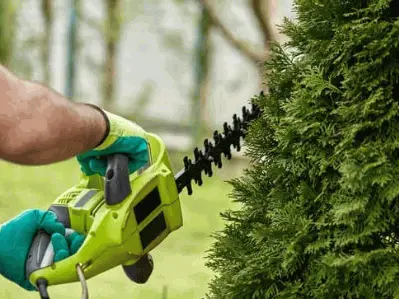
Types Of Hedge Trimming Equipment Suitable For Shaping
There are various types of trimmers on the market, but an electric hedge trimmer is particularly well-suited for shaping hedgerows due to its precise cutting capabilities. Other options, such as cordless and gas-powered hedge trimming equipment, can also be effective. You can also check out our post “Best Tool For Cutting Hedges” for more additional insights.
Choosing The Right Hedge Trimmer For Shaping
Consider factors such as the size and type of your bushes, power source preferences, and blade length and features when selecting an electric hedge trimmer for shaping purposes. Telescopic handles can provide added convenience and reach for shaping taller hedges.
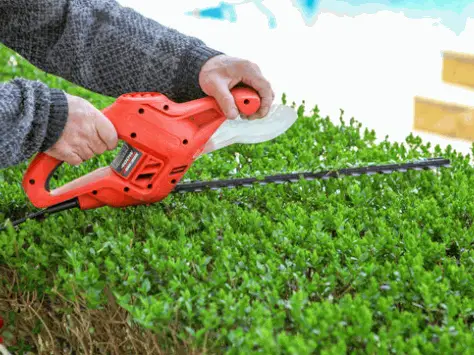
Preparing For Shaping
Before diving into the shaping process, making necessary preparations and ensuring your safety is essential.
Safety Precautions Before Using A Hedge Trimmer
Prioritise safety by wearing protective gear, gloves, safety goggles, and sturdy footwear. Additionally, inspect the hedge trimmer to ensure it’s in proper working condition and clear the work area of any obstacles or debris.
Examining The Hedge For Shaping
Look closely at your hedge, identifying areas with overgrown or uneven growth that need shaping. Consider the desired shape and style you wish to achieve and mark guidelines accordingly for precise trimming. Also be on the lookout for nesting birds, or anything which will pose a hazard when trimming the hedge.
Step-by-Step Guide For Shaping With A Hedge Trimmer
Now, let’s dive into the step-by-step process of shaping hedges when working with a hedge trimmer.
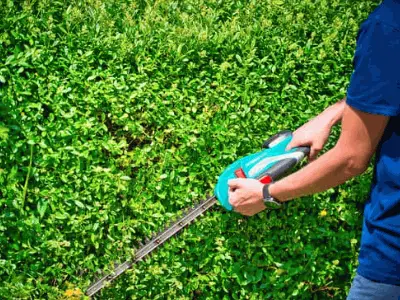
Trimming The Sides Of The Hedge
When you use a hedge trimmer, be sure to hold it correctly, ensuring a firm grip and proper control. Start from the bottom of the hedge and work your way upwards, trimming vertically. Focus on creating straight lines and smooth edges for a polished appearance.
Trimming The Top Of The Hedge
Use a level or string as a guide to achieving an even top when you trim bushes or hedgerows. Trim horizontally, moving the timmer from one side to the other to create a level top. If you prefer a tapered or rounded shape, angle the trimmer to achieve the desired effect. To get a better understanding of topping hedges techniques and tips, we suggest taking a look at our comprehensive blog article.

Trimming Intricate Shapes And Details
Use hand pruners in conjunction with the hedge trimmer for intricate shapes or detailed patterns. This allows for precise cuts and greater control, enabling you to create unique designs while maintaining symmetry and balance.
Maintenance And Care
Proper maintenance and care are crucial to ensure the longevity of your hedge trimmer and maintain its performance.
Cleaning The Hedge Trimmer After Use
After every time you use a trimmer, remove debris and sap build-up from the blades and body of the trimmer. Wipe it down with a clean cloth and consider using a brush to reach crevices. Lubricate the blades and moving parts as the manufacturer recommends, and store the trimmer safely. For more information, you can check out our posts “Best Way To Lubricate Hedge Trimmers” and “Best Way To Store Hedge Trimmers“.
Sharpening And Replacing Trimmer Blades
Dull blades can compromise the effectiveness of your hedge trimmer. Look for signs of dullness and sharpen the blades using appropriate techniques and tools. If the blades are beyond sharpening, replace them to maintain optimal cutting performance. For more learnings, you can check out our posts “How To Sharpen A Hedge Trimmer” and “How To Clean Hedge Trimmer Blades“.
What Are Some Common Mistakes To Avoid When Shaping Hedges?
Try to avoid these mistakes when shaping hedges:
- Avoid trimming hedges into geometric shapes that are too formal or unnatural; aim for an organic and natural look that complements the surrounding landscape.
- Do not cut hedges at an angle, as it can lead to a wider top than the base, hindering sunlight from reaching lower branches and causing thinning and bare spots.
- Maintain sharp blades on your hedge trimmer to avoid jagged cuts that harm the hedge’s health.
- Avoid over-pruning or removing excessive foliage at once, as this can weaken the hedge and hinder its ability to recover.
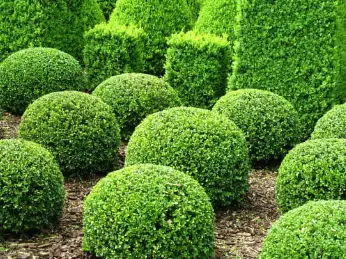
Frequently Asked Questions
To get the best from your electric hedge trimmer, please consider the following FAQs.
How Do You Shape Hedges With A Hedge Trimmer?
To shape when you use a hedge trimmer:
- Examine the hedge and identify the areas that require shaping.
- Hold the trimmer securely and begin by trimming the sides of the hedge, moving from the bottom upwards vertically, ensuring straight lines and smooth edges.
- For the top of the hedge, use a level or string as a guide and trim horizontally from one side to the other to maintain a level top. If you desire a tapered or rounded shape, adjust the angle of the trimmer accordingly.
- Combine a hedge trimmer with hand pruners for precise cuts for intricate shapes and details.
It’s essential to work carefully, maintaining symmetry and balance throughout the shaping process.

When Should I Start Shaping My Hedges?
The best time to start shaping hedges depends on your specific type of hedge. For deciduous hedges, shape them during late winter or early spring before new growth begins. This timing allows you to shape the hedge before it becomes too dense.
On the other hand, evergreen hedges can be shaped throughout the year, but it is often best to trim them in late spring or early summer when their growth rate is highest. It’s essential to consider your hedges’ specific needs and growth patterns when determining the ideal time to start shaping them.
How Do You Trim Overgrown Bushes With A Hedge Trimmer?
Trimming overgrown bushes with a hedge trimmer requires a systematic approach. Begin by assessing the bush and determining the desired shape you want to achieve. Remove dead or damaged branches first, then gradually thin out the dense areas by selectively trimming branches. Our post “Thinning Overgrown Hedges With Your Hedge Trimmer” maybe interest you. You can check it out.
Trim the sides of the bush in an upward motion, starting from the bottom and working your way to the top. Pay attention to maintaining a balanced shape and avoid cutting too much at once to prevent shock or damage to the bush. Regularly assess your progress to ensure you achieve the desired shape as you trim.
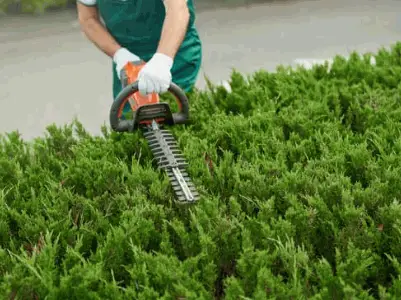
Can A Hedge Trimmer Cut Down A Bush?
While a hedge trimmer is suitable for shaping and maintaining hedges, there may be more practical tools for cutting down a bush entirely. Hedge thinners and trimmers trim foliage and branches, not for cutting through thicker wood or large stems. For cutting down a bush, use a more appropriate tool, such as a pruning saw or a lopper, which are best for heavier cutting tasks.
Are There Any Alternative Tools For Shaping Hedges?
While hedge thinners and trimmers are the most commonly used tools for shaping hedges, alternative tools are available. Hand pruners and shears are commonly used for detailed shaping and precision trimming. They allow for more controlled and intricate cuts, which can be especially useful for shaping small or delicate hedges.
Additionally, topiary shears are designed to create complex shapes and patterns in hedges and shrubs. These tools provide greater manoeuvrability and precision when shaping hedges, allowing for more creative and artistic designs.
Using a hedge trimmer is a fantastic way to shape your hedges and create stunning designs. By following the step-by-step guide and implementing the expert tips of Equipment Girl, you can achieve beautiful hedge shapes with precision and ease. Remember to prioritise safety, choose the right electric hedge trimmer for your needs, and maintain your trimmer regularly for long-lasting performance.

